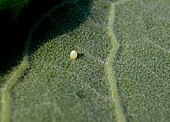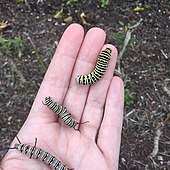Nicole Smith
Thesis and Theory of Monarch butterfly & Milk-Weed
monarchs undergo complete metamorphosis; their life cycle has four phases: egg, larva, pupa, and adult. Monarchs transition from eggs to adults during warm summer temperatures in as little as 25 days, extending to as many as seven weeks during cool spring conditions. During their development, both larvae and their milkweed hosts are vulnerable to weather extremes, predators, parasites, and diseases; commonly fewer than 10% of monarch eggs and caterpillars survive.[24]: (pp21-22)
Egg[edit]
The egg is derived from materials ingested as a larva and from the spermatophores received from males during mating.[33] Female monarchs lay eggs singly, most often on the underside of a young leaf of a milkweed plant during the spring and summer.[34] Females secrete a small amount of glue to attach their eggs directly to the plant. They typically lay 300 to 500 eggs over a two- to five-week period.[35]
Eggs are cream colored or light green, ovate to conical in shape, and about 1.2×0.9 mm in size. The eggs weigh less than 0.5 mg each and have raised ridges that form longitudinally from the point to apex to the base. Although each egg is 1⁄1000 the mass of the female, she may lay up to her own mass in eggs. Females lay smaller eggs as they age. Larger females lay larger eggs.[33] The number of eggs laid by a female, which may mate several times, can reach 1,180.[36]
Eggs take three to eight days to develop and hatch into larvae or caterpillars.[24]: (p21) The offspring's consumption of milkweed benefits health and helps defend them against predators.[37][38] Monarchs lay eggs along the southern migration route.[39]
Larva[edit]
The larva (caterpillar) has five stages (instars), molting at the end of each instar. Instars last about 3 to 5 days, depending on factors such as temperature and food availability.[5][40]
The first-instar caterpillar that emerges from the egg is pale green or grayish-white, shiny, and almost translucent, with a large, black head. It lacks banding coloration or tentacles. The larvae or caterpillar eats its egg case and begins to feed on milkweed with a circular motion, often leaving a characteristic, arc-shaped hole in the leaf. Older first-instar larvae have dark stripes on a greenish background and develop small bumps that later become front tentacles. The first instar is usually between 2 and 6 mm long.[40]
The second-instar larva develops a characteristic pattern of white, yellow, and black transverse bands. The larva has a yellow triangle on the head and two sets of yellow bands around this central triangle. It is no longer translucent, and is covered in short setae. Pairs of black tentacles begin to grow, a larger pair on the thorax and a smaller pair on the abdomen. The second instar is usually between 6 mm and 1 cm long.[40]
The third-instar larva has more distinct bands and the two pairs of tentacles become longer. Legs on the thorax differentiate into a smaller pair near the head and larger pairs further back. Third-instar larvae usually feed using a cutting motion on leaf edges. The third instar is usually between 1 and 1.5 cm long.[40]
The fourth-instar larva has a different banding pattern. It develops white spots on the prolegs near its back, and is usually between 1.5 and 2.5 cm long.[40]
The fifth-instar larva has a more complex banding pattern and white dots on the prolegs, with front legs that are small and very close to the head. Fifth-instar larvae often chew a shallow notch in the petiole of the leaf they are eating, which causes the leaf to fall into a vertical position. Its length ranges from 2.5 to 4.5 cm.[5][40]
As the caterpillar completes its growth, it is 4.5 cm long (large specimens can reach 5 cm) and 7 to 8 mm wide, and weighs about 1.5 g, compared to the first instar, which was 2 to 6 mm long and 0.5 to 1.5 mm wide. Fifth-instar larvae greatly increase in size and weight. They then stop feeding and are often found far from milkweed plants as they seek a site for pupating.[40]
In a laboratory setting, the fourth- and fifth-instar stages of the caterpillar showed signs of aggressive behavior with lower food availability. Attacked caterpillars were found to be attacked when it was feeding on milkweed leaves, and the caterpillars attacked when foraging for milkweed.[41] This demonstrates the aggressive behavior of monarch caterpillars due to the availability of milkweed.





Comments
Post a Comment